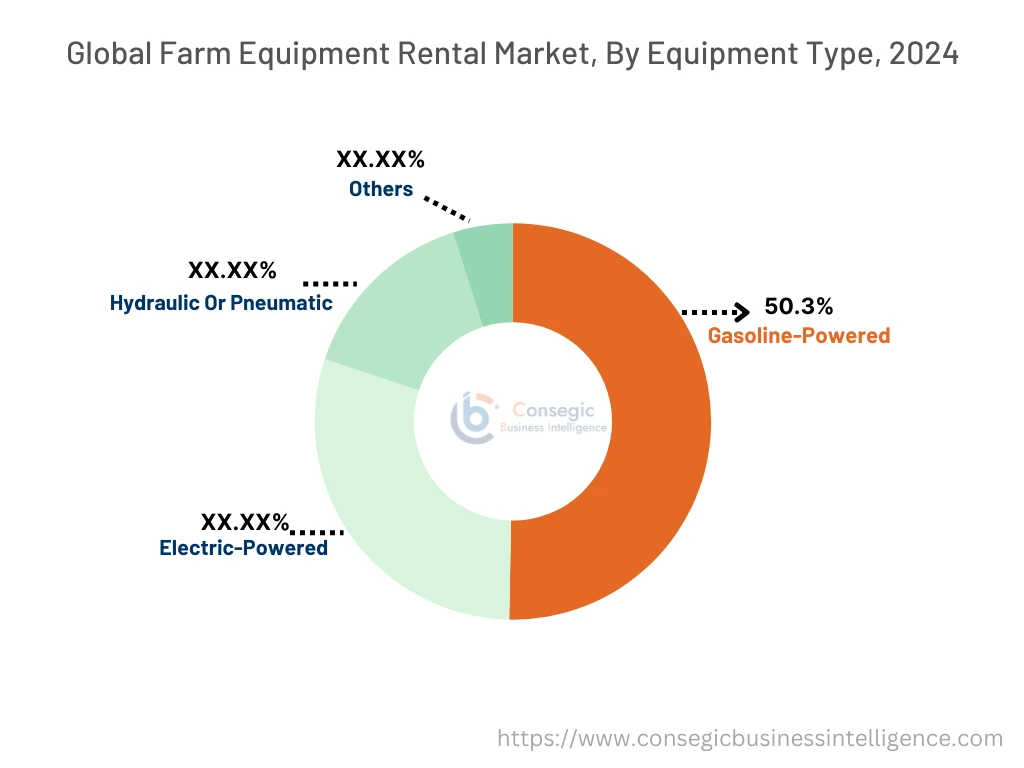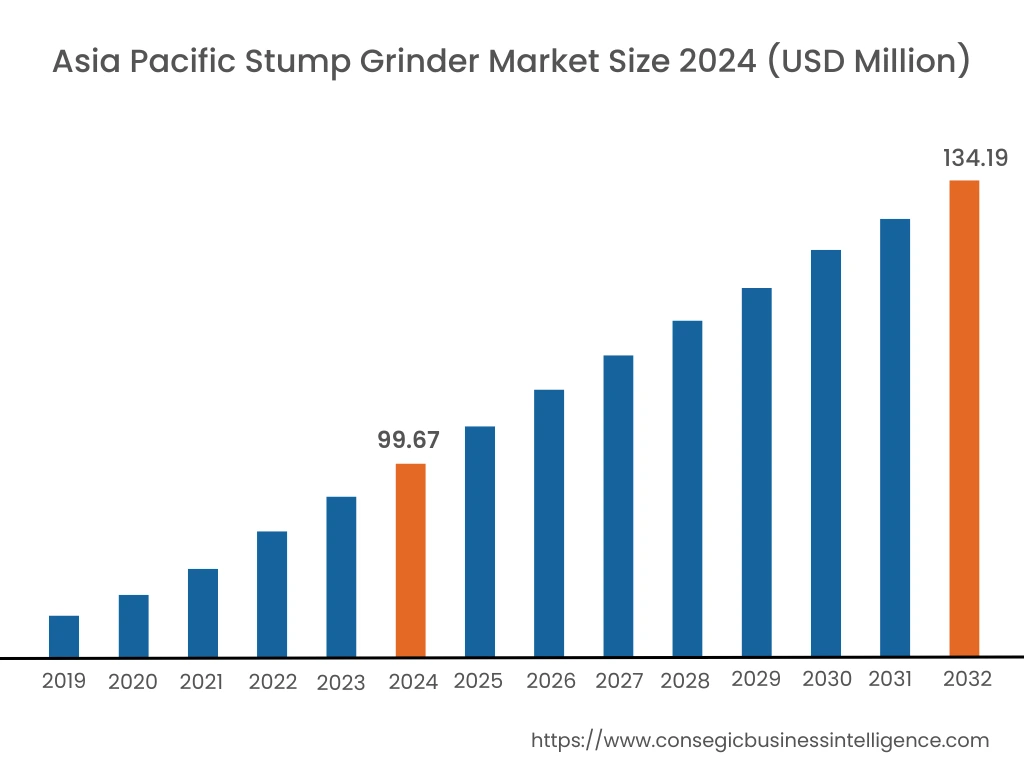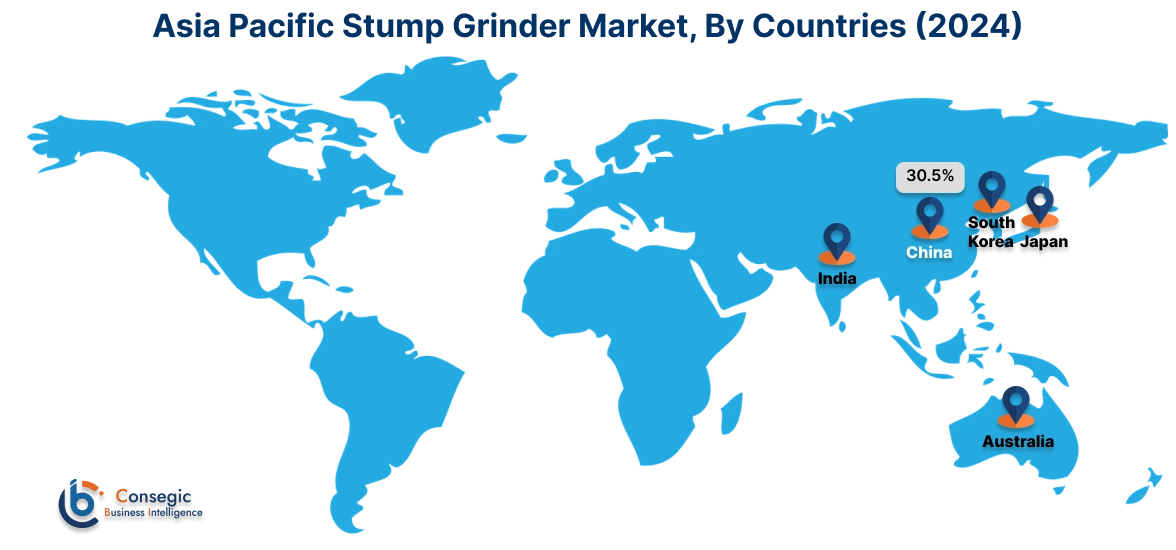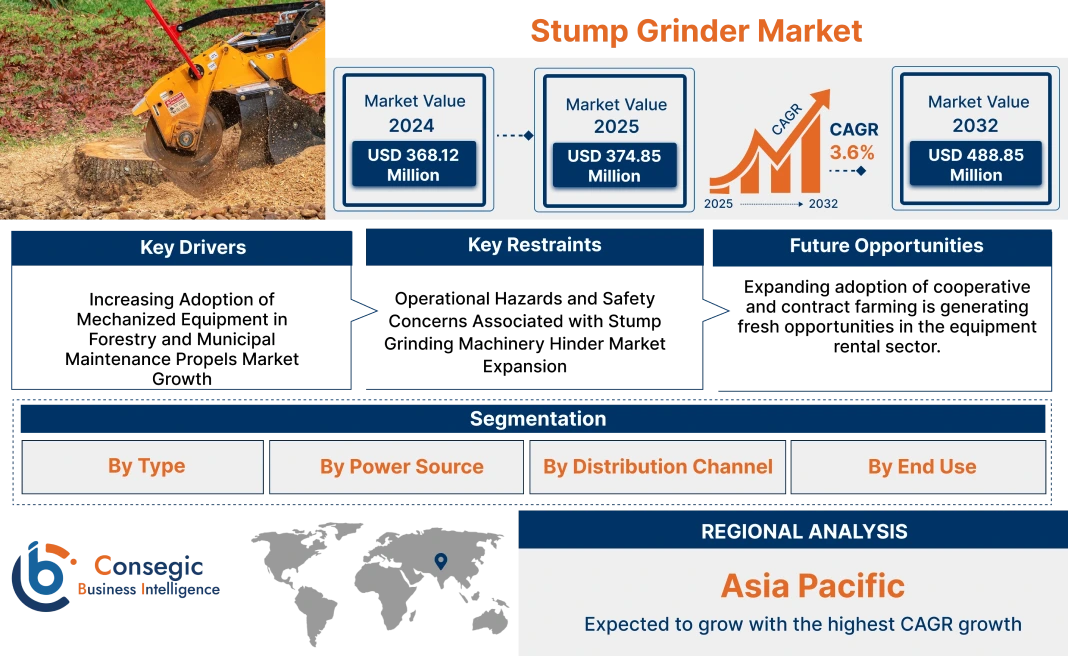- Summary
- Table Of Content
- Methodology
Stump Grinder Market Size:
Stump Grinder Market size is estimated to reach over USD 488.85 Million by 2032 from a value of USD 368.12 Million in 2024 and is projected to grow by USD 374.85 Million in 2025, growing at a CAGR of 3.6% from 2025 to 2032.
Stump Grinder Market Scope & Overview:
A stump grinder is a mechanized cutting tool designed to remove tree stumps by grinding them into small wood chips below ground level. It is commonly used in landscaping, forestry, and land clearing operations for efficient post-harvest site preparation.
Available in wheeled, tracked, and attachment-mounted configurations, these machines feature rotating cutting wheels with hardened teeth, adjustable depth settings, and safety guards. Variants range from compact units suitable for residential use to heavy-duty versions designed for commercial-scale clearing.
The equipment allows for precise control, fast operation, and minimal ground disturbance. By eliminating the need for chemical treatments or manual digging, stump grinders improve jobsite efficiency and reduce labor intensity. Their ability to handle various stump sizes and terrain conditions makes them a valuable asset for contractors, municipal services, and property maintenance professionals seeking clean, hazard-free land surfaces for further development or restoration.
Key Drivers:
Increasing Adoption of Mechanized Equipment in Forestry and Municipal Maintenance Propels Market Growth
Forestry operations and municipal maintenance departments are increasingly shifting from manual stump removal to mechanized grinding solutions to improve operational efficiency and reduce labor intensity. Stump grinders are being utilized to streamline clearing activities following tree felling, storm damage, or urban redevelopment projects. Municipalities use these machines for maintaining public parks, sidewalks, and roadsides where fast and safe removal of stump remnants is necessary. Their versatility, ranging from walk-behind units to tow-behind and tracked models, makes them suitable for diverse terrains and project scales. As labor shortages persist and productivity expectations rise, operators are investing in machinery that offers consistent performance and time savings. This trend is particularly strong in North America and Europe, where land management and urban forestry are well-established. With increasing demand for mechanized ground clearing and vegetation control, the sector continues to witness steady stump grinder market expansion.
Key Restraints:
Operational Hazards and Safety Concerns Associated with Stump Grinding Machinery Hinder Market Expansion
Despite their functional advantages, stump grinding machines present significant safety risks when not operated under proper conditions. High-speed cutting wheels, flying debris, and proximity to underground utilities introduce hazards for both operators and nearby personnel. Equipment misuse or lack of training often results in injury or property damage, especially in residential or confined urban settings. Safety concerns are further compounded when users bypass protective shields or operate machinery on uneven terrain. These risks reduce confidence among smaller contractors or municipal bodies with limited training budgets. In regions with stringent occupational safety regulations, acquiring and maintaining compliance adds to operational costs and complexity. Additionally, insurance premiums for operating such equipment may deter entry for individual service providers. Although demand for efficient stump removal remains, these safety and liability concerns continue to act as barriers to broader stump grinder market growth.
Future Opportunities :
Integration of Remote-Controlled and Automated Systems for Enhanced Safety and Efficiency Offers Market Opportunities
Advancements in machine automation are unlocking new possibilities in stump grinder design and operation. Manufacturers are introducing remote-controlled systems that allow operators to manage equipment from a safe distance, minimizing direct exposure to cutting zones. These systems improve operator visibility, maneuverability in tight spaces, and response accuracy during complex stump removal tasks. Additionally, semi-autonomous features such as depth sensors, programmable grinding patterns, and obstacle detection are being incorporated into high-end models. These upgrades reduce fatigue, shorten learning curves, and enhance job site safety. As demand grows for safer and more productive ground-clearing equipment, professional arborists, municipalities, and rental fleet operators are increasingly seeking smart, user-friendly models. These technology-driven innovations are opening new stump grinder market opportunities centered on operational safety, labor efficiency, and precision-based landscaping outcomes.
Stump Grinder Market Segmental Analysis :
By Type:
Based on type, the stump grinder market is segmented into walk-behind, self-propelled, tow-behind, and others.
The walk-behind segment accounted for the largest revenue share in 2024.
- Walk-behind stump grinders are compact, portable, and highly suitable for residential use and small-scale commercial applications.
- These machines are ideal for homeowners and landscaping professionals dealing with small to medium-sized tree stumps.
- They offer ease of use and maneuverability, making them a preferred choice for tight spaces and residential areas.
- As per stump grinder market analysis, walk-behind models remain dominant due to their versatility, lower cost, and convenience in smaller applications.
The self-propelled segment is projected to grow at the fastest rate during the forecast period.
- Self-propelled models provide enhanced mobility and ease of operation compared to walk-behind models, especially in larger yards or commercial projects.
- They are equipped with higher horsepower engines, enabling them to handle larger stumps with better efficiency.
- Increased adoption by tree care companies and landscaping businesses looking for higher productivity is driving this segment’s growth.
- According to stump grinder market trends, the need for self-propelled machines is accelerating due to their increased operational efficiency and user-friendly features.
By Power Source:
Based on power source, the market is segmented into gasoline-powered, electric-powered, hydraulic or pneumatic, and others.
The gasoline-powered segment held the largest stump grinder market share of 50.3% in 2024.
- Gasoline-powered machines are the most common and widely adopted due to their affordability, high power output, and flexibility for use in remote areas.
- These machines are ideal for heavy-duty applications, providing high torque for grinding large stumps and roots.
- Their widespread adoption across residential, commercial, and industrial applications is driven by their reliability and ease of fuel access.
- As per stump grinder market analysis, gasoline-powered grinders dominate due to their performance and long operational life.
The electric-powered segment is projected to grow at the fastest CAGR during the forecast period.
- Electric-powered models are gaining popularity due to their low emissions, quieter operation, and reduced environmental impact compared to gasoline models.
- These machines are increasingly used in residential and urban areas where noise pollution is a concern.
- The growing focus on sustainability and energy efficiency is driving innovation in electric-powered models, particularly for smaller applications.
- According to stump grinder market trends, the rise in eco-consciousness and stricter environmental regulations is contributing to the increased requirement for electric-powered machines.

By Distribution Channel:
Based on distribution channel, the stump grinder market is segmented into direct sales, distributors, online retail, and dealers & OEMs.
The direct sales segment accounted for the largest revenue share in 2024.
- Direct sales allow manufacturers to establish direct relationships with customers, ensuring better product knowledge and support.
- Large construction and landscaping companies often prefer direct purchases to ensure the right machine specifications and custom features.
- This channel allows for the customization of products and provides more control over pricing and delivery.
- Thus, the dominance of direct sales is due to the personal engagement it offers, which is essential for the professional-grade equipment market and drives the stump grinder market demand.
The online retail segment is expected to register the fastest CAGR.
- The rise of e-commerce platforms has made it easier for both residential and commercial customers to purchase them online.
- Online retail offers a broad range of models with detailed specifications, user reviews, and competitive pricing, making it highly convenient for buyers.
- With the advent of online marketplaces and direct-to-consumer sales models, this segment is gaining traction globally.
- Hence, the convenience of online shopping, along with improved logistics, is driving the stump grinder market expansion.
By End User:
Based on end-use, the market is segmented into residential, commercial, and industrial.
The residential segment held the largest stump grinder market share in 2024.
- Residential want for them is driven by homeowners looking to remove stumps from their yards, especially in rural and suburban areas.
- Walk-behind and electric-powered models are especially popular among homeowners due to their ease of use and lower cost.
- The growing trend of homeownership, along with an increased interest in DIY landscaping, supports the ongoing need in this segment.
- As per stump grinder market demand, residential applications continue to lead as the most consistent source of growth, with a focus on affordability and simplicity.
The commercial segment is projected to grow at the fastest CAGR during the forecast period.
- Commercial applications, particularly tree care services, landscaping companies, and municipal utilities, are driving the need for more powerful, self-propelled machines.
- These businesses require high-performance stump grinders to handle larger projects and offer professional-grade services.
- The growth in construction and infrastructure projects, along with urban landscaping demand, is further fueling this segment’s expansion.
- According to stump grinder market growth projections, commercial and industrial applications are becoming increasingly prominent as cities expand and landscaping services increase.
Regional Analysis:
The regions covered are North America, Europe, Asia Pacific, the Middle East and Africa, and Latin America.

Asia Pacific region was valued at USD 99.67 Million in 2024. Moreover, it is projected to grow by USD 101.60 Million in 2025 and reach over USD 134.19 Million by 2032. Out of this, China accounted for the maximum revenue share of 30.5%. The Asia-Pacific region is witnessing steady growth in the stump grinder industry, driven by urbanization, road development projects, and government-funded tree plantation schemes. In countries like China, Japan, Australia, and South Korea, the demand for stump removal is expanding across infrastructure corridors, parks, and residential construction zones. Market analysis shows rising adoption of skid-steer attachments and hydraulic grinders that offer operational flexibility across varied terrain. In Australia, the need for bushfire prevention and land restoration is contributing to equipment upgrades among forestry contractors. The region’s growth trajectory is further supported by local manufacturing capacity and increasing awareness of mechanized vegetation control methods.

North America is estimated to reach over USD 162.84 Million by 2032 from a value of USD 122.38 Million in 2024 and is projected to grow by USD 122.38 Million in 2025. North America leads the stump grinder market, with extensive usage in both commercial landscaping and municipal forestry operations. The United States and Canada exhibit high market maturity, where arborists, groundskeeping services, and utility maintenance crews rely on self-propelled and tow-behind models. Market analysis highlights the increasing need for low-emission, compact, and remote-controlled units designed for urban environments and tree removal near utility lines. Growth in this region is supported by regulatory pressure to manage invasive root systems and post-storm cleanup operations, alongside a rising preference for fleet-based service models that incorporate stump grinding into broader tree care packages.
Europe presents a technology-forward and environmentally conscious market, particularly in countries like Germany, the United Kingdom, and the Netherlands. Adoption is focused on compact stump grinding solutions suitable for densely built environments, parks, and heritage sites. Market analysis reveals a growing interest in battery-electric and low-noise models due to strict urban noise ordinances and emissions targets. Many municipalities and landscape contractors are integrating them into sustainable forestry programs and replanting strategies. The stump grinder market opportunity in Europe is strengthened by public sector investment in green infrastructure and increasing emphasis on low-impact arboricultural practices.
Latin America is an emerging market, with usage gradually increasing in Brazil, Mexico, and Chile. Market analysis indicates that growth is primarily concentrated in commercial landscaping, plantation forestry, and municipal tree maintenance programs. Operators are favoring portable and tractor-mounted units that are easier to deploy in remote or uneven areas. Environmental restoration projects and urban greening initiatives are driving demand in metropolitan regions. The market opportunity in Latin America lies in expanding equipment accessibility, improving training for safe and efficient use, and integrating stump grinding into broader land-clearing services.
The Middle East and Africa are in early stages of adoption, though regional activity is rising in South Africa, the UAE, and Kenya, particularly in urban landscaping and resort developments. In desert and semi-arid areas, stump grinding is used selectively in landscaping conversions and invasive species control. Market analysis reveals that commercial property developers and municipal authorities are incorporating stump grinding equipment in land preparation strategies to support construction and horticultural projects. While limited infrastructure and cost sensitivity remain barriers, long-term growth is expected as awareness of environmental land management practices increases.
Top Key Players and Market Share Insights:
The stump grinder market is highly competitive with major players providing products and services to the national and international markets. Key players are adopting several strategies in research and development (R&D), product innovation, and end-user launches to hold a strong position in the global stump grinder market. Key players in the stump grinder industry include -
- FSI Stump Cutters (Denmark)
- Husqvarna Group (Sweden)
- RAYCO Manufacturing, Inc. (USA)
- Fecon, Inc. (USA)
- Jo Beau Products (Belgium)
- Cramer GmbH (Germany)
- Turf Teq (Canada)
- GTM Professional (Netherlands)
- Caravaggi S.r.l. (Italy)
- GreenMech Ltd. (United Kingdom)
Recent Industry Developments :
Product Launch:
- In August 2024, FSI Stump Cutters launched FSI B31-980 in response to market needs. Equipped with a narrow design (74cm), reliable performance, stability and manoeuvrability, the model provides higher horsepower operation.
Acquisitions:
- In January 2024, Namakor Holdings acquired CMI Mulching, a manufacturer of tracked mulching tractors and stump grinders. This acquisition aims to propel the firm’s growth to new levels.
- In December 2023, the global manufacturer of heavy-duty site preparation attachments and forestry accessories, Fecon, acquired Stumper Industries, the manufacturer of stump grinder attachments.
Partnerships:
- In February 2024, FSI announced a new UK partner network for nationwide coverage of services with consistent and localized support. The network consists of numerous companies, including but not limited to Global Plant Sales, ILH Groundcare and Landpower Machinery.
Stump Grinder Market Report Insights :
| Report Attributes | Report Details |
| Study Timeline | 2019-2032 |
| Market Size in 2032 | USD 488.85 Million |
| CAGR (2025-2032) | 3.6% |
| By Type |
|
| By Power Source |
|
| By Distribution Channel |
|
| By End-use |
|
| By Region |
|
| Key Players |
|
| North America | U.S. Canada Mexico |
| Europe | U.K. Germany France Spain Italy Russia Benelux Rest of Europe |
| APAC | China South Korea Japan India Australia ASEAN Rest of Asia-Pacific |
| Middle East and Africa | GCC Turkey South Africa Rest of MEA |
| LATAM | Brazil Argentina Chile Rest of LATAM |
| Report Coverage |
|
Key Questions Answered in the Report
How big is the Stump Grinder Market? +
Stump Grinder Market size is estimated to reach over USD 488.85 Million by 2032 from a value of USD 368.12 Million in 2024 and is projected to grow by USD 374.85 Million in 2025, growing at a CAGR of 3.6% from 2025 to 2032.
What specific segmentation details are covered in the Stump Grinder Market report? +
The Stump Grinder market report includes specific segmentation details for type, power source, distribution channel and end-use.
What are the end-use of the Stump Grinder Market? +
The end-use of the Stump Grinder Market are residential, commercial, and industrial.
Who are the major players in the Stump Grinder Market? +
The key participants in the Stump Grinder market are FSI Stump Cutters (Denmark), Husqvarna Group (Sweden), RAYCO Manufacturing, Inc. (USA), Fecon, Inc. (USA), Jo Beau Products (Belgium), Cramer GmbH (Germany), Turf Teq (Canada), GTM Professional (Netherlands), Caravaggi S.r.l. (Italy) and GreenMech Ltd. (United Kingdom).


